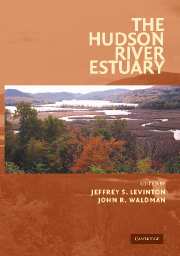Book contents
- Frontmatter
- Contents
- Preface
- List of Contributors
- The Hudson River Estuary
- 1 The Hudson River Estuary: Executive Summary
- GEOLOGICAL, PHYSICAL, AND CHEMICAL SETTING OF THE HUDSON
- PRIMARY PRODUCTION, MICROBIAL DYNAMICS, AND NUTRIENT DYNAMICS OF THE HUDSON
- HUDSON RIVER COMMUNITIES, FOOD WEBS, AND FISHERIES
- CONTAMINANTS AND MANAGEMENT ISSUES OF THE HUDSON RIVER ESTUARY
- 22 The History and Science of Managing the Hudson River
- 23 Hudson River Sewage Inputs and Impacts: Past and Present
- 24 PCBs in the Upper and Tidal Freshwater Hudson River Estuary: The Science behind the Dredging Controversy
- 25 Transport, Fate, and Bioaccumulation of PCBs in the Lower Hudson River
- 26 Contaminant Chronologies from Hudson River Sedimentary Records
- 27 Atmospheric Deposition of PCBs and PAHs to the New York/New Jersey Harbor Estuary
- 28 Toxic Substances and Their Impact on Human Health in the Hudson River Watershed
- 29 Impacts of Piers on Juvenile Fishes in the Lower Hudson River
- 30 Physiological and Genetic Aspects of Toxicity in Hudson River Species
- Index
- Plate section
- References
26 - Contaminant Chronologies from Hudson River Sedimentary Records
Published online by Cambridge University Press: 06 January 2010
- Frontmatter
- Contents
- Preface
- List of Contributors
- The Hudson River Estuary
- 1 The Hudson River Estuary: Executive Summary
- GEOLOGICAL, PHYSICAL, AND CHEMICAL SETTING OF THE HUDSON
- PRIMARY PRODUCTION, MICROBIAL DYNAMICS, AND NUTRIENT DYNAMICS OF THE HUDSON
- HUDSON RIVER COMMUNITIES, FOOD WEBS, AND FISHERIES
- CONTAMINANTS AND MANAGEMENT ISSUES OF THE HUDSON RIVER ESTUARY
- 22 The History and Science of Managing the Hudson River
- 23 Hudson River Sewage Inputs and Impacts: Past and Present
- 24 PCBs in the Upper and Tidal Freshwater Hudson River Estuary: The Science behind the Dredging Controversy
- 25 Transport, Fate, and Bioaccumulation of PCBs in the Lower Hudson River
- 26 Contaminant Chronologies from Hudson River Sedimentary Records
- 27 Atmospheric Deposition of PCBs and PAHs to the New York/New Jersey Harbor Estuary
- 28 Toxic Substances and Their Impact on Human Health in the Hudson River Watershed
- 29 Impacts of Piers on Juvenile Fishes in the Lower Hudson River
- 30 Physiological and Genetic Aspects of Toxicity in Hudson River Species
- Index
- Plate section
- References
Summary
abstract Analyses of sections from dated sediment cores have been used to construct contaminant chronologies in the Hudson River Basin and the New York/New Jersey Harbor complex. Dating information was derived primarily from radionuclide analyses. The known input history of 137Cs, a radionuclide derived from global fallout and nuclear reactor discharges, places important constraints on estimates of net sediment accumulation rates. 7Be, a natural radionuclide with a 53 day half-life is detectable in surficial samples with a significant component of particles deposited within a year of core collection. Persistent contaminants analyzed in dated Hudson sediments include PCBs, dioxins, chlorinated hydrocarbon pesticides, and trace metals such as copper, lead, zinc, cadmium, chromium, and mercury. The combination of temporal and geographic information from these analyses is most valuable and provides a general basinwide perspective on the significant improvement in contaminant levels in the Hudson over the past several decades. It has also allowed us to trace the influence of several major contamination incidents in the basin, including PCB and trace metal inputs to the Upper Hudson River and dioxin and DDT discharges to the Lower Passaic River.
Introduction
Over the past several decades, many thousands of sediment samples have been collected from the Hudson River, its tributaries and the New York/New Jersey (NY/NJ) Harbor complex (Fig. 26.1). This chapter will focus on insights gained from analyses on a very select subset of those samples – sections of dated sediment cores.
- Type
- Chapter
- Information
- The Hudson River Estuary , pp. 383 - 397Publisher: Cambridge University PressPrint publication year: 2006
References
- 10
- Cited by



